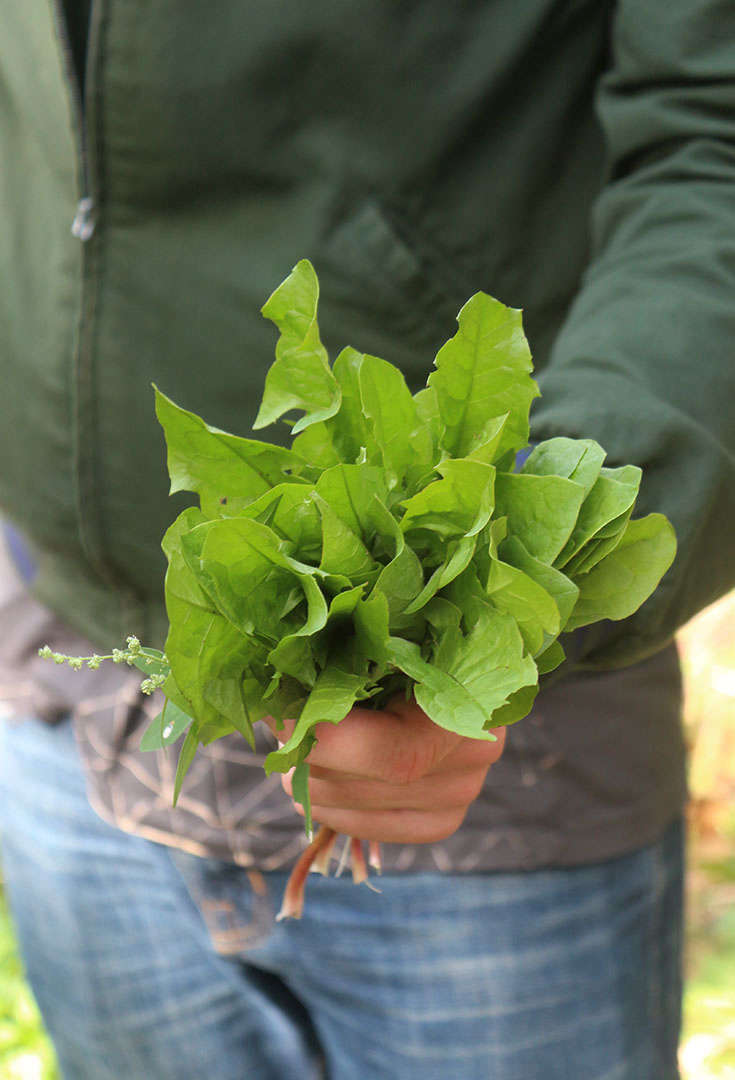Spring is coming, and the arrival of green edible plants is almost audible. To celebrate, this week we’re launching a new series of seasonal recipes for foragers: Weeds You Can Eat.
Where to begin with an edible weed primer? If you’re looking for the botanical equivalent of nose-to-tail eating, dandelions (Taraxacum species) are a good place to start: root, crown, leaves, flowers – all edible.
Photography by Marie Viljoen.
Above: Common dandelions are one of the most familiar of the cosmopolitan weeds. Their bright yellow flowers sing spring and make this useful food easy to spot in a sea of green.
Sunny dandelion blooms appear singly on hollow stalks, which bleed a white latex when picked (some dandelion lookalikes have branching flower stems and fibrous stalks).
Above: Dandelion leaves are dentated—meaning they have tooth-like edges (the teeth point back down toward the stem). The French name for dandelion is dent-de-lion. Lion’s teeth. A more archaic French term for dandelion is pissenlit: pee in bed, referring to its reported diuretic properties (this may be a plant to avoid in quantity—if juicing, for example—if you have compromised kidney function).
Above: Unlike the weedists, I think a lawn covered in dandelions is a beautiful sight—pollen and nectar for insects, and food for humans, too. So your own (untreated) lawn might be the best place to look for this versatile perennial vegetable. Never gather edible plants near roads and railways—both for heavy metal and for glyphosate (Roundup) reasons.
Dandelions are packed with Vitamins K, A, and C, and contain healthy doses of minerals, notably iron and calcium.
Above: Dandelions are good to eat almost as soon as the ground thaws, when they are at their mildest and most succulent.
Once you have found their basal rosettes growing flush with the cold ground, the whole crown can be dug up. Trim off most of the root and any winter-battered leaves. Soak the intact crown in a basin of water (rinse and repeat) to remove all soil particles. Dry well and enjoy them raw in a salad, quick-pickled, or cooked: sautéed lightly in olive oil, with lemon juice, capers, anchovies and pepper; with butter, a drizzle of soy sauce, and a pinch of sugar; or dipped in a tempura batter, deep-fried and served with lemon wedges. Early spring and late fall are the best times to harvest the root to eat fresh, or to dry and grind for use as a warm beverage (I am not patient enough to have done this more than once).
As spring progresses the leaves will become more strongly flavored. The mildest are harvested from plants that have not yet flowered, and also from dandelions that grow in shade. They can be eaten right through to the beginning of winter but will become more assertive and bitter as the weather warms (late fall can produce a fresh flush of mild leaves).
Above: Mature dandelion leaves are best cooked. In her beautiful book Vegetables from Amaranths to Zucchini ($48.23 from Amazon), the author Elizabeth Schneider writes: “The bitterness can be balanced with roasted nut oils, fruit or sherry or balsamic vinegars, and cheese with sharpness and acidity…or mitigate the bitterness with citrus fruit or beets.” The cooked leaves also make good fillings for Middle Eastern-style pies
Above: If you have the patience to collect them, dandelion flowers make a very appealing mead or lightly alcoholic fizz. Covered with water and some sugar in a jar, the natural yeasts get to work to produce an effervescent drink that can be enjoyed after a few days, or aged further for dandelion wine.
Above: My favorite way to eat dandelions is based on the classic salade Lyonnaise, where the leaves are dressed in a warm vinaigrette and crunchy bits of bacon, rounded out by sunny egg yolks. I serve it as bruschetta.
Dandelion Bruschetta (A Light Lunch for Two)
Cooking bacon in a hot oven makes it beautifully crisp and flat, and it does not spit at you. If you prefer the stove, cook your bacon there.
Ingredients
- 1 tablespoon sherry vinegar
- ½ teaspoon sugar
- Pinch of salt
- Freshly ground black pepper
- 4 strips bacon
- 2 eggs
- 2 slices toasted sourdough bread
- 1 clove garlic
- ½ pound dandelion leaves, washed and dried
- 1 tablespoon olive oil
Instructions
Pre-heat the oven to 450 degrees F.
Mix the vinegar with the sugar and salt until those dissolve. Set aside.
Lay the bacon flat in a cast iron skillet or heavy pan and place in the hot oven. Roast the bacon until it is crisp (about 10 minutes), turning once.
Boil the eggs for 8 minutes, then dunk in cold water and peel. Chop them roughly—the yolks should be barely set.
While the bacon and eggs are cooking, toast the bread. As soon as it is toasted rub both sides with the raw clove of garlic, cut each slice in half and set aside on a plate.
As soon as the bacon is cooked, remove it from the pan and set aside. Pour off all but 1 tablespoon of the rendered bacon fat. Immediately toss the dandelion leaves into the fat in the very-hot pan and stir. Add the vinegar mixture at once and toss again, adding the olive oil last. Pile the wilted leaves onto the toasted bread, break the bacon into pieces, and scatter on top of the dandelions. Finally add the egg. If there are any pan juices left, drizzle these over the top of your bruschetta. Serve at once.
For more wild-inspired recipes, see Weekend Forager: Are Those Mushrooms Edible? and Required Reading: The Forager’s Kitchen.



















Have a Question or Comment About This Post?
Join the conversation (3)